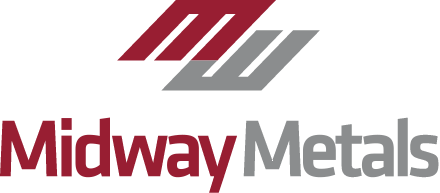Stainless Steel Blanking Lines
Many manufacturers and industries demand flat material and Midway Metals can deliver. Our state-of-the art blanking lines produce stainless steel sheets with superior flatness, using a precision grip feed system for tight and consistent tolerances.
Absolutely Laser Flat
With two Red Bud Industries Precision Blanking Lines, Midway Metals can produce stainless steel sheets and plates at a variety of thickness’ and widths, and with PE coatings edge-to-edge.
Our cut to length capabilities include:
- 0.50mm to 3.00mm thick x 1500mm wide capacity (from 200mm to 6250mm long plates)
- 0.70mm to 10.00mm thick x 2000mm wide capacity (from 300mm to 13000mm long plates)
With one of our blanking lines including an in-line stretcher leveller, the material can be stretched beyond its yield point to reset the material’s memory from the milling process. The material is stretched from top to bottom and edge to edge, releasing all internal stresses and producing a perfectly flat product.
Stretcher levelling is superior to other techniques currently used in Australia.
It’s the only process guaranteed to flatten the material without reducing the thickness (a common problem with temper passing). And, while temper passing and roller levelling can reduce the internal stresses in the material, they will not reset it. Only stretcher levelling can reset a material’s memory.
Download Brochure
Benefits for Fabricators
- Material remains flat after folding and punching
- Eliminates need for rework from warping
- No tensile spring-back – only need to fold/bend material once to achieve desired angle
- Saves time with no unnecessary rework
- Process doesn’t change mechanical properties
Benefits for Laser Cutters
- Midway Metal’s laser flat material
- Material doesn’t warp when laser cuts with high heat
- Improved material quality allows for consistent cutting
- Material stays flat after laser cutting
- Likelihood of damage to laser heads decreased when cutting
- Ability to retain accuracy when cutting long
Blanking Line Capabilities
| Minimum | Maximum | |
|---|---|---|
| Coil Weight | 2,000kgs | 24,040kgs |
| Coil Width | 152mm | 2,210mm |
| Coil ID | 483mm | 635mm |
| Coil Diameter | N/A | 2,134mm |
| Thickness | 0.51mm | 10mm |
| Sheet Length | 300mm | 12,000mm |
| Length Tolerances | 0 to 3,000mm | 3,001mm to 6,000mm | 6,001mm to 9,000mm |
|---|---|---|---|
| 0.51mm to 8mm thick | +/- 0.13mm | +/- 0.26mm | +/- 0.39mm |
| 10mm thick | +/- 2mm | +/- 3mm | +/- 4.5mm |



Frequently Asked Questions
What is a Steel Blanking Line?
A steel blanking line is the process of mechanically or hydraulically pressing or stamping a steel coil into a flat shape. The steel blanks are cut to a precise length with corner-to-corner tolerance.
The steel blanking lines stretch the material from bottom to top, edge to edge. This process ensures no warping or tensile spring-back when using stainless steel. These flat steels can be used for different purposes.
How do we process Stainless Steel Blanks?
At Midway Metals, our blanking line process involves three stages.
- In the first stage, the mandrel and roller levellers achieve initial flatness and drive the material to the grip feeders. The crop shear also helps to get the initial square edge.
- The stretcher leveller does the main job of flattening the steel to exceed the yield point without reducing the thickness of the steel. The quality and molecular composure of the steel remains the same, and internal stress from the milling process is reset to produce perfectly flat sheets.
- With our shear and drop stacker, the steel is cut to length. The motor grip feeder of the stacker ensures length tolerance and squareness are maintained.
You can have your steel sheet cut to 300mm minimum and 12,000mm maximum. With the stainless steel blanks, you won’t have to rework your steel to get the best results.
Why can you trust our Steel Blanking Lines?
Whether you’re a fabricator or intend to laser-cut your stainless steel, you can trust our blanking lines. Our blanking lines process ensures that the steel remains flat even after folding and punching. The mechanical properties of the steel remain the same. You also won’t have to worry about warping or tensile spring back as you use the steel.
During laser cuts, the material wouldn’t warp under high heat. There are also fewer chances of damage to your laser heads as you cut. With consistency in thickness and unchanged material quality, you can cut for a long time with increased accuracy. You get to save time and money as you can use your stainless steel for more in a shorter period.
